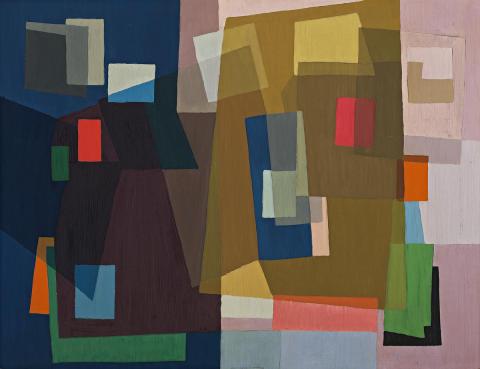CONSTRUCTIVE PAINTING, 1953
RALPH BALSON
oil on composition board
84.0 x 109.0 cm
signed and dated lower right: R Balson. 53.
Gallery A, Sydney
The Estate of the late James O. Fairfax AC, New South Wales, acquired from the above in 1968
Ralph Balson Second Memorial Exhibition, Gallery A, Sydney, 18 July 1968, cat. 25
Ralph Balson: A Retrospective, 15 August – 24 September 1989, Heide Park and Art Gallery, Victoria; and then touring to Newcastle Region Art Gallery, Newcastle, 6 October – 19 November 1989; Wollongong City Gallery, Wollongong, 1 December 1989 – 28 January 1990; Art Gallery of New South Wales, Sydney, 14 February – 1 April 1990 and University Art Museum, University of Queensland, Brisbane, 12 April – 24 May 1990, cat. 25 (as ‘Painting, 1953’)
Adams, B., Ralph Balson: A Retrospective, exhibition catalogue, Heide Park and Art Gallery, Victoria, 1989, cat. 25, pp. 24, 49 (illus.), 80
In July 1941 Ralph Balson held his second solo exhibition at Anthony Hordern’s Fine Art Galleries in Sydney. Comprising a suite of lively abstract geometric compositions painted in arresting combinations of colour (and unusually, including metallic paint in silver, gold and bronze), the exhibition was a landmark event within the history of Australian art, representing the first ever display of non-objective painting. As Deborah Edwards has noted, ‘in the arena of Australian war-time modernism … [these paintings] constituted the uncompromising claim that representational modes could no longer be part of a mission to poetically embody the modern condition and universal values’.1 Focusing on the influence of Constructivism on local artists, a significant new contribution to the study of modernism in Australia similarly acknowledges Balson’s pioneering role, noting that in their ‘harmonious integration of colour with form, geometry and dynamism’ the 1941 paintings hold ‘a composure and conviction that must have seemed revelatory at their first showing’.2 These radical works and the ideas that inspired them – from developments in contemporary science to diverse artistic influences – would form the basis of Balson’s practice for the next fifteen years. As he saw it, these ‘constructive paintings’ presented ‘a new expression of reality apposite to modern conditions through constructed relationships of colour and shape’.3
Balson was a self-employed house-painter by trade and until his retirement at the age of 65, weekends were the only time available for making art. The practiced skills of his profession – colour mixing and the careful application of paint – must have helped the development of his art rather than hindered it and perhaps the limited time he had available encouraged Balson’s keen focus on his creative direction. Balson had come to art late, his first formal studies being part-time evening classes at Julian Ashton’s school in the early 1920s. By the mid-1930s however, he was part of a dynamic group of Sydney artists including Grace Crowley, Rah Fizelle, Frank and Margel Hinder, who had knowledge and (sometimes firsthand) experience of progressive international art. Well-read and connected to expatriate Australians working overseas who kept them up to date with new developments, this group was at the vanguard of modernism in Australia.4
While some of Balson’s constructive paintings follow the right-angled geometry of Mondrian, who he once described as his ‘greatest single influence’, this work from 1953 breaks away from the order of verticals and horizontals, juxtaposing a series of less regular shapes that playfully jostle for prominence. There is an energetic movement across the painting’s surface in the complex layering of forms and the push-pull between positive and negative space. Striking colour relationships play a key role too, as oranges and vivid watermelon pink sit atop rich blues and purples, olive green and to the right, paler shades of mauve and grey. While at first glance, some colours appear to have been painted over others to create a darker tone, each colour has been applied individually, independent of those immediately adjacent, emphasising Balson’s understanding of colour and virtuoso skill with the chromatic possibilities of his medium. One of the larger scale works painted towards the end of his constructive series, this painting reflects Balson’s confidence and mastery of abstract form and colour.
1. Edwards, D., ‘A New Realm of Visual Experience’, Ralph Balson -/41: Anthony Horderns’ Fine Art Galleries, exhibition catalogue, Ivan Dougherty Gallery, College of Fine Arts, University of New South Wales, Sydney, 2008, p. 36
2. Harding, L., ‘Part One: 1920-1970’, Harding, L. and Cramer, S., Call of the Avant-Garde: Constructivism and Australian Art, exhibition catalogue, Heide Museum of Modern Art, Melbourne, 2017, p. 43. The exhibition at Heide Museum of Modern Art, on display from 5 July – 8 October 2017, features numerous ‘constructive’ paintings by Balson.
3. Badham, H., A Study of Australian Art, Currawong Publishing Co., Sydney, 1949, p. 146
4. James, B., Ralph Balson, A Restrospective, exhibition catalogue, Heide Park and Art Gallery, Melbourne, 1989 and Taylor, E., Grace Crowley: Being Modern, exhibition catalogue, National Gallery of Australia, Canberra, 2006
KIRSTY GRANT
Former Director of Heide Museum of Modern Art
Former Senior Curator, National Gallery of Victoria
